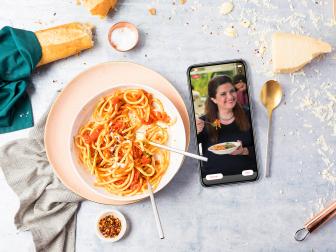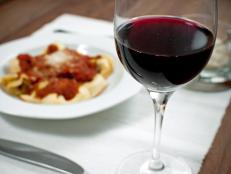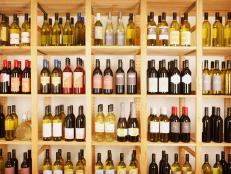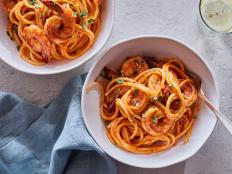How to Serve and Store Wine
No wine fridge or fancy gadgets required.

UpperCut Images
Get The All-New Food Network Kitchen App
Download Food Network Kitchen now to sign up and take advantage of the latest offer and get 40+ live classes a week, hundreds of on-demand cooking classes, in-app grocery ordering and so much more.
There's so much emphasis placed on buying the perfect bottle of wine that we give relatively little consideration to what happens next (besides drinking it). Temperature is a key but often overlooked factor for both storing and serving wine. While you don't need a wine fridge or fancy gadgets, there are some easy measures you can take to ensure you're drinking your wine at a temperature that best showcases its flavor. Whether you're taking down a weeknight malbec or need a last-minute hack for chilling a bottle of bubbly, follow these wine pros' tips for optimizing your wine drinking experience.
Why temperature matters
Across the board, wine pros say that prior to opening, wine should be stored in a cool, dark place. Michael Kennedy, vintner, sommelier and founder of Component Wine Company, says that if you're short on pantry space, the coat closet works great.
When it comes to what temperature to serve wine at, sommeliers agree that you are the best judge of what you like and how you like to drink it — there are no wrong answers here. That said, there are some general guidelines for serving temperatures that can optimize the taste of the wine and your enjoyment of it.
"The key is that when wine is too warm, alcohol will evaporate and negatively affect the aromatics and taste. If wine is too cold — say, below 45 degrees Fahrenheit — you will not benefit from any of the aromatics, as it will hide those," says Max Kast, a Master Sommelier and director of education for Broadbent Selections. He offers temperature ranges for a few different styles:
- Sparkling wines, sweet wines and lighter-bodied aromatic white wines should be served at the coolest temperatures, a few degrees below or above 50 degrees F.
- For fuller-bodied whites, rosés and lighter-bodied red wines, go slightly warmer, a few degrees below or above 55 degrees F.
- Medium-bodied and full-bodied red wines should be a few degrees below or above 62 degrees F.
Kast also recommends keeping glassware at room temperature, so plan ahead to avoid plucking warm glasses from the dishwasher or washing them at the last minute. Kast is a fan of glasses with stems, because the stem keeps your hands off the globe of the glass and prevents them from warming the glass — which you generally want to avoid, unless the wine is too cold to begin with.
Chilling wine
You don't need a wine fridge to get your bottle to an ideal temperature. Here are a few easy ways to chill your bottle using what you already have in your kitchen.
Fridge: If you're planning to serve red wine, Kennedy recommends stashing a room-temperature bottle in the fridge an hour before guests are expected to arrive, then removing it half an hour before serving, to allow the wine to warm up. For whites, Kast says taking the bottle out of the fridge and letting it warm up for 10 minutes or so on the counter is a good idea, or you can pour wine directly from the fridge and let it warm up in the glass for a few minutes.
Freezer: If you have only 10 or 15 minutes to chill a bottle, Kennedy suggests wrapping the bottle in two or three layers of wet paper towels and stashing it in the freezer. Be sure to set a timer, to avoid making wine slushies.
Ice bath: To quickly chill a room-temperature bottle of wine, nothing beats a quick ice-bucket bath. Kast recommends filling an ice bucket three-quarters full, with a mix of half ice and half water, then plunging the bottle in. About 15 minutes should do it for a bottle of white, and perhaps closer to 30 for a bottle of red, but use your best judgment to gauge if the bottle is at your desired temperature. Then take it out and leave it on the table, to prevent the wine from getting too cold. (Keep the ice bucket close by, though, in case the wine starts to get too warm and needs a refresher chill.)
If you're someone who likes to save wine labels, follow Kennedy's pro tip: "If you are serving very fine wines and want the label to be protected while chilling on ice, put the bottle in a plastic bag, then insert into ice. This ensures the label stays dry and beautiful."
Saltwater ice bath: Extra short on time for chilling a red? Kennedy's ultimate hack is a saltwater ice bucket. Why salt? It lowers the freezing point, making for a colder water temperature and allows you to chill a bottle in 15 to 20 minutes. He always keeps a 26-ounce can of iodized salt in the pantry for just such an occasion. Follow these easy steps to chilled-wine bliss:
- Place the wine bottle in an empty wine ice bucket. (It's important to do this before filling the bucket with ice and water.)
- Fill the bucket around the bottle completely with ice all the way to the top.
- Add water to fill halfway to the top; the ice will break down a bit; add more ice, then more water to fill to the top of the bucket.
- Add about 2 tablespoons of salt, and stir or spin the bottle to mix the salt with the water.
- Set aside, spinning the bottle every 5 minutes for 15 to 20 minutes. Then it should be ice-cold and ready to go!
Protecting your investment
If you don't finish the bottle, you can extend the life of your wine with some easy storage tips.
"Cork it, fridge it," recommends Kennedy, explaining that the cooler temperature can slow the oxidation rate and give you an extra day or more (some wines can last two to four days when recorked and kept in the fridge).
Kast prefers to consume wine within 24 hours of opening, storing open bottles of white in the fridge and open bottles of red in a cool part of the house. "As far as how long a bottle can be open, it depends on the wine," he says. "Some wines are made for immediate consumption, while others are wines that will be better the next day — generally new vintages of wines that have the potential to age."
And don't be afraid to drink next-day Champagne. Esteban Brunello, sommelier and owner of Bar Brunello in Durham, North Carolina, says, "I think a lot of sommeliers are going to crucify me for this, but I enjoy it more after the bubbles come down a little bit. Again, [it comes down to] personal preference."
A note on natural wines
Like other wines, natural wines do best in a cool, dark space — a coat closet, the basement and even under your bed are spots that work well, according to Tony Aquilina, beverage director at Lou, a restaurant and natural-wine bar in Nashville, Tennessee. For whites and sparkling wines, he recommends letting them warm up a little bit after opening. "I find that non-fruit characteristics shine at slightly warmer temperatures," Aquilina says. "Notes of almond, hazelnut, cheese and toast can become present once the wine warms up a few degrees. These notes typically come from the aging process that the wine goes through."
Aquilina also decants most of the wines he drinks at home, whether they're red, white or sparkling. If you don't have a decanter, any large glass vessel should do the trick. If you don't finish the bottle, recork it and stash it in the fridge. "Natural wines can grow and evolve for typically three to five days while open, although some might have a shorter or longer life," he says.
Related Stories:



































